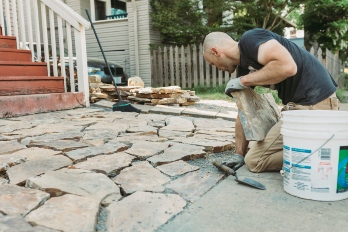This post is part of our ongoing series on home heating systems and costs.
How do you heat your home? If we had to guess, you probably have a furnace, a boiler, or a heat pump. These make up about 80% of all home heating systems in the United States.
Wait … why do folks have supplemental heat sources? Because they’re cold! And they don’t want to spend more money on fuel, or add wear and tear, by cranking up the furnace. Supplemental heat also lets you warm up one area or room rather than your entire home.
Interested in learning more about supplemental heat sources? Let’s take a look at the pros and cons of the most common types. 
Traditional fireplace
When it comes to ambiance, nothing beats the warm glow of a fire. Fireplaces are one of the oldest forms of home heating. Wood is the most common fuel for a fireplace, though gas and electric fireplace inserts are available (see the gas heaters section below).
Though they create a pretty atmosphere, they’re usually only about 10-15% efficient. Most of the heat created leaves through the chimney. Fireplaces without special inserts or covers also draw warm air from the rest of the house to feed the fire, which can actually lower the temperature.
Quick definition: “Efficiency” is the amount of heat a system creates from the fuel it burns.
Despite their lower efficiency, fireplaces are pretty darn reliable. Since they don’t require electricity, you can use them during a power outage, and they’re fairly simple to operate and maintain.
Be aware of fire risks while burning inside your home, however. Burning wood creates creosote, a tarlike substance that sticks to the inside of your chimney and can cause chimney fires. Coals can also escape your fireplace. Always keep an eye on your fire and be sure to have your chimney cleaned and inspected once per year.
Pros
- Affordable
- Easy to operate
- Useable during power outages
Cons
- Low efficiency
- Higher fire hazard
- Medium maintenance
Wood stove
Another classic, wood stoves offer a safe, enclosed place to burn wood inside your home. They’re typically made of cast iron or steel. (Start making some strong friends if you plan to move and install one yourself.) You’ll need 3 feet of clearance on all sides of the wood stove and a chimney to vent smoke out of your home.
Newer, Environmental Protection Agency (EPA)-certified wood stoves are typically 60-70% efficient. Wood is also fairly inexpensive to acquire, making them an affordable option. That said, you’ll need to store and move wood, which can require some physical labor.
While they don’t require electricity and can be used during power outages, wood stoves can also be a bit more complicated than other supplemental heating sources. The right amount of air flow through the stove is crucial for the most efficient burn, so you’ll have to get familiar with the damper and air valve controls.
Creosote (a tar-like residue created by burning wood) can also build up in your wood stove and chimney. This happens faster if your fires burn too low or if you burn damp wood. To be safe, experts recommend an annual professional chimney inspection and cleaning. Wood stoves also get quite hot, so keep children, furniture, and drapes at a safe distance.
Pros
- Affordable
- Efficient
- Usable during power outages
Cons
- Storing and carrying wood
- Needs adequate space in your home
- Medium maintenance




